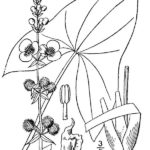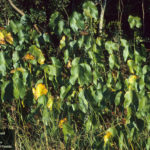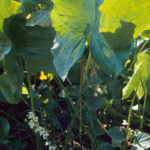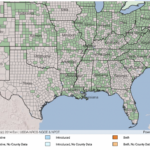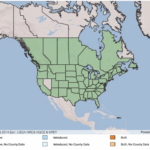Sagittaria latifolia
USDA, NRCS. 2018. The PLANTS Database (http://plants.usda.gov, 28 March 2018). National Plant Data Team, Greensboro, NC 27401-4901 USA.
Illustration: USDA-NRCS PLANTS Database / Britton, N.L., and A. Brown. 1913. An illustrated flora of the northern United States, Canada and the British Possessions. 3 vols. Charles Scribner’s Sons, New York. Vol. 1: 99.
What is Broadleaf Arrowhead?
Other common spellings and names include: duckroot, duck-potato, wapato.
Physical Characteristics
Leaves:
- Straight or straight spreading
- Triangular or egg-shaped leaf blades
- Arrowhead shaped
- Portion above the base lobes up to 10 inches long & wide
Flowers:
- Sepals up to 0.39 inches long
- Boat-shaped
- Somewhat dry
- Stamen have slender filaments
- Stamen usually longer than anthers
- Up to 1 inch in diameter
- Blooms Jul – Sep
Fruit:
- Egg-shaped
- 0.14 inches long & 0.13 inches wide
Stem:
Where Does it Grow?
Broadleaf arrowhead can be found in still water or wet places like marshes.
Pros and Cons of Arrowhead
Called duck potato or wapato because of its edible egg-shaped rhizomes. The tubers of arrowheads are prized foods by ducks, geese, muskrats, and nutria containing an excellent source of carbohydrates. Seeds are sometimes consumed by ducks. Submerged portions of all aquatic plants provide habitats for many micro and macro invertebrates. These invertebrates in turn are used as food by fish and other wildlife species (e.g. amphibians, reptiles, ducks, etc.). After aquatic plants die, their decomposition by bacteria and fungi provides food (called “detritus”) for many aquatic invertebrates.
